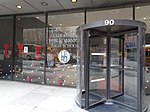Zuccotti Park

Zuccotti Park (formerly Liberty Plaza Park) is a 33,000-square-foot (3,100 m2) publicly accessible park in the Financial District of Lower Manhattan, New York City. It is located in a privately owned public space (POPS) controlled by Brookfield Properties and Goldman Sachs. Zuccotti Park is bounded by Broadway to the east, Liberty Street to the north, Trinity Place to the west, and Cedar Street to the south. The park was created in 1968 by Pittsburgh-based United States Steel, after the property owners negotiated its creation with city officials. It was named Liberty Plaza Park because it was situated one block south of One Liberty Plaza. The park's northwest corner is across the street from Four World Trade Center. It has been popular with local tourists and financial workers. The park was heavily damaged in the September 11 attacks and subsequent recovery efforts of 2001. The plaza was later used as the site of several events commemorating the anniversary of the attacks. After renovations in 2006, the park was renamed by its current owners, Brookfield Office Properties, after company chairman John Zuccotti. In 2011, the plaza became the site of the Occupy Wall Street protest camp, during which activists occupied the plaza and used it as a staging ground for their protests throughout the Financial District.
Excerpt from the Wikipedia article Zuccotti Park (License: CC BY-SA 3.0, Authors, Images).Zuccotti Park
Cedar Street, New York Manhattan
Geographical coordinates (GPS) Address Nearby Places Show on map
Geographical coordinates (GPS)
| Latitude | Longitude |
|---|---|
| N 40.709228 ° | E -74.011247 ° |
Address
United States Realty Building
Cedar Street
10006 New York, Manhattan
New York, United States
Open on Google Maps








